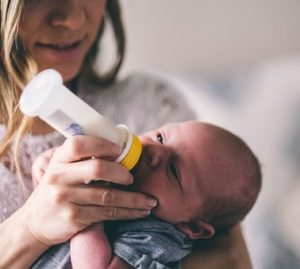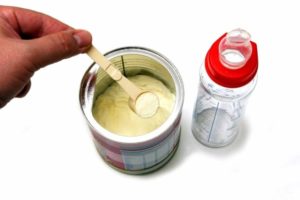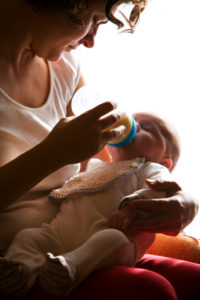Human milk is the best type of milk for your baby. For medical or personal reasons, you may decide to formula feed your baby.
Skin-to-skin contact with your baby is still important and beneficial to you and your baby regardless of how they are fed. When feeding your baby holding them close and making eye contact during the feed is important for bonding and development.
Using formula
Iron-fortified infant formula should be used until your baby is 9-12 months old and is eating a variety of iron-rich foods at least twice per day. Homogenized, 2%, 1% , skim, goat and plant based milks do not provide your baby with proper nutrition. The protein and minerals are not easily digested by young babies and these milks do not contain adequate energy or fat for your growing baby and are a poor source of iron.
Commercial formula is usually cow’s milk that has been changed to be more easily digested. There are a variety of formulas available. Buying infant formula over the internet or from stores outside of Canada is not recommended.
You must follow the directions on the formula containers exactly. Your baby may get sick if the formula is not prepared or stored correctly.
Check the expiry date on each container before you use it. Based on manufacturer’s instructions, use formula immediately or refrigerate bottles as directed. Throw out any unused formula after the recommended time.
Do not freeze infant formula. Freezing can change the texture of the formula. Powdered infant formula that has been frozen may not mix well with water.
Sterilize all equipment used to prepare and store milk for infants less than four months of age before each use. Place equipment in a pot of boiling water for two minutes, or according to manufacturer’s instructions. This is a precautionary recommendation made by Health Canada and Alberta Health. The sanitizing cycle of the dishwasher that is NSF-184 approved is also acceptable. After babies are four months of age, it is recommended that items are washed in hot soapy water and rinsed in hot water.
Use glass or Bisphenol-A free (BPA-free) plastic containers.
Check artificial nipples before each use to make sure that they have no signs of damage (such as tears, cracks, swelling, tackiness or stickiness). This could result in a choking hazard for babies. If the nipple becomes cracked, torn, or shows signs of breakdown, replace the product right away.

Types of formula
Powdered formula
- Powdered formula is not sterile. Follow the manufacturer’s instructions exactly for formula use, preparation and storage.
- It is preferred to prepare and use infant formula right away, however if formula needs to be prepared ahead of time refer to Healthy Parents Healthy Children for instructions.
- If you use water from a private supply, have the water tested before you feed it to your baby. Talk to your local community health centre about this. Bottled water is not sterile.
- All water used should also be boiled for at least two minutes and then cooled before mixing until baby is at least 4 months old

Concentrated formula
- Pour the concentrated formula into sterile bottles. Follow the manufacturer’s instructions for the amount of water to be added. Boil the water for the first 2 minutes and then cool if before mixing. Follow this procedure until your baby is at least 4 months old.
- It is preferred to prepare and use infant formula right away, however if formula needs to be prepared ahead of time refer to Healthy Parents Healthy Children for instructions.
- If you use water from a private supply, have the water tested before you feed it to your baby. Talk to your local community health centre about this.
- Bottled water is not sterile. It should also be boiled for at least two minutes and then cooled before mixing.
Ready-to-feed formula
- Comes in either cartons/cans or in ready to feed bottles.
- If the formula is in a carton/can pour it into a sterile bottle before using. Do not add water to the ready-to-feed infant formula.
- If your baby is typically taking less than the amount in the carton or ready to feed bottle it can be divided into two bottles before using to avoid wastage.
- If not being used put the formula in the fridge right away. Make sure to use it within 48 hours, unless the formula has different instructions.
Feeding your baby formula
To warm refrigerated formula, place the bottle in a container of warm water for no more than 15 minutes until the formula is lukewarm. Shake the warmed bottle of formula to mix it and test the formula temperature on your wrist. The formula should be cool to the touch. If it’s warm to the touch it may be too hot to feed your baby.
Once you have fed your baby, throw away any leftover formula from the feed after 2 hours – do not reheat leftover formula or put in back in the refrigerator.
Warming milk in a microwave is not advised as microwaves heat milk unevenly and form hot spots that can burn your baby.
- Cuddle your baby during feeding. This is an important time for you and your baby to get to know each other.
- Hold your baby close to you with their head and upper body slightly elevated.
- Hold the bottle so that the formula fills the nipple to prevent your baby from swallowing air.
- Follow your baby’s cues, let them take a break from feeding if they need to and don’t force your baby to finish the bottle or take more than they need.
- Do not prop the bottle in your baby’s mouth or put your baby to bed with a bottle. Your baby may choke on the formula. Also, propping a bottle may cause developing teeth to be damaged and increase the chance of your baby developing ear infections.

How often will my formula-fed baby feed?
Most newborns will feed at least 5 times in the first day (24 hours). Do not expect your baby to follow a schedule. Feed your baby whenever he or she shows signs of hunger (such as, moving hands to the mouth or making smacking noises with the mouth).
Babies are all different. Over time you will get to know your baby’s needs, and signs of hunger and fullness (turning away, closing mouth, falling asleep). The amount of formula that your baby drinks will increase. During your baby’s first few days you can expect your baby to drink small amounts at a time. Slowly increase the amount of formula you feed your baby at each feed.
Do not wait until your newborn baby cries before feeding as she or he may be too upset to enjoy the feeding.
You’ll know that your baby is getting enough to eat if he or she:
- Has 6 to 8 wet diapers in 24 hours after about 4 days of age.
- Has pale-coloured urine.
- Has soft, easily passed stools.
- Wakens to be fed at least 6 times in 24 hours.
For more detailed information about whether your baby is getting enough, visit Healthy Parents Healthy Children.
At about 2 weeks you can expect 6 to 10 feeds per day of about 60 to 90 ml (2 to 3 oz) of formula per bottle. From 3 to 8 weeks of age, this will change to 5 to 8 feeds of about 90 to 150 ml ( 3 to 5 oz) per feed. Call your nurse or doctor if you have questions about feeding.
| For more information about feeding your baby infant formula, click here. |